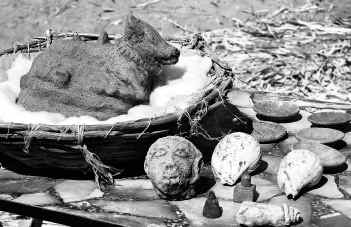|
Three granite pillars with
inscriptions of Pallava and Chola kings
The Hindu, 17 March 2007
|

Rare Find: A terracotta bull, a
female head made of terracotta, miniature lingam
made out of green-stone, a copper bell, conches
and terracotta lamps discovered by the ASI at
Salavankuppam near Mamallapuram.
|
CHENNAI: In its renewed excavation at
Salavankuppam close to Tiger Cave near Mamallapuram, the
Archaeological Survey of India (Chennai Circle) has
discovered three granite pillars with inscriptions of
Pallava and Chola kings. According to archaeologists, the
inscriptions confirm that a structural temple built of
bricks, dedicated to Subrahmanya, existed at the spot on
the beach. It belonged to the pre-Pallava period or late
Tamil Sangam age and could be 1,700 years old.
The inscriptions on the pillars belong to the Pallava
period of 8th century A.D. when Thirukin Kizhavar was the
local chieftain, the Pallava period of early 9th century
A.D. when Nripatunga Varman was the ruler, and 998 A.D.
when Raja Raja Chola was in his 13th regnal year. The
inscriptions, in Tamil, are about the donation of gold
and land for the temple and the maintenance of its
perpetual lamp at Thiruvizhchil, which is present-day
Salavankuppam. There is an inscription of Raja Raja Chola
on the floor near the entrance to the Shore Temple. He
built the Brihadisvara temple in Thanjavur.
Among the ruins of the temple complex at Salavankuppam,
the ASI has also discovered a terracotta bull (Nandi), a
miniature (4 cm tall) Sivalingam made of polished
green-stone, the terracotta head of a woman, a miniature
copper bell, a Chola copper coin, moulded bricks,
amphorae jars, terracotta lamps, stucco decorations, lids
of pots, potsherds and conches. The exquisite Nandi, in
the sitting position, has a pronounced hump, a garland of
bells and wide jaws. The woman's head has an expressive
face, arched eyebrows, big eyes and pupils.
The three pillars are in addition to the five pillars
with inscriptions discovered at the site by the ASI
during its excavations in 2005 and 2006.
These five inscriptions belong to Pallava kings
Dantivarman (813 A.D.), Nandivarman III (818 A.D.),
Kambavarman (9th century A.D), Rashtrakuta king Krishna
III (971 A.D), and Chola king Rajendra III (13th century
A.D). In 2005, the ASI also found an inscription of
Kulotunga Chola in a nearby rocky outcrop. All the
inscriptions refer to donations of land and gold for the
maintenance of the temple at Thiruvizhchil ( The Hindu ,
July 12, 2005, September 21, 2005, and March 28,
2006).
Sathyabhama Badhreenath, Superintending Archaeologist,
ASI (Chennai Circle), said: ``What is significant is
that, from the Pallava kings of the 8th century A.D. to
the Chola kings of the 13th century A.D, the Subrahmanya
temple continuously received patronage. All these
inscriptions mention Thiruvizhchil.''
G. Thirumoorthy, Assistant Archaeologist, ASI, called it
``the biggest brick temple complex dating back to the
pre-Pallava period.'' He assigned it to circa 3rd century
A.D.
The inscription of Thirukin Kizhavar stated that the
chieftain made a gift of five ``kazhanju'' (small balls)
of ``pon'' (gold) and that the interest accruing from it
should go towards buying oil for the temple's lamp.
Nripatunga Varman's was about land donation to the
temple. Raja Raja Chola's inscription about Thiruvizhchil
spoke of ``brahmadeyam,'' that is, the deity and Brahmins
becoming equal owners of temple land, and ``devadanam,''
the donation of land for administering the temple.
The temple, facing north, had two entrances, from the
east and the west.
It was the first brick temple complex to be exposed in
Tamil Nadu, Sathyabhama Badhreenath said. She described
the figurine of the bull, which is 26 cm in height, 25 cm
long and 18 cm broad, as ``a rare piece.'' Thirumoorthy
called this discovery ``a fortune'' because ``a Nandi
made of terracotta has not been reported so far.'' The
unearthing of the figurines of Nandi and the Shivalingam,
and of Ganesha earlier ``indicated that the temple was
dedicated to the Saivite pantheon,'' he said.
While the temple was built of bricks in the pre-Pallava
period and damaged by tidal action, the Pallavas
converted it into a granite temple. This, too, was ruined
by a tsunami or tidal action.
|